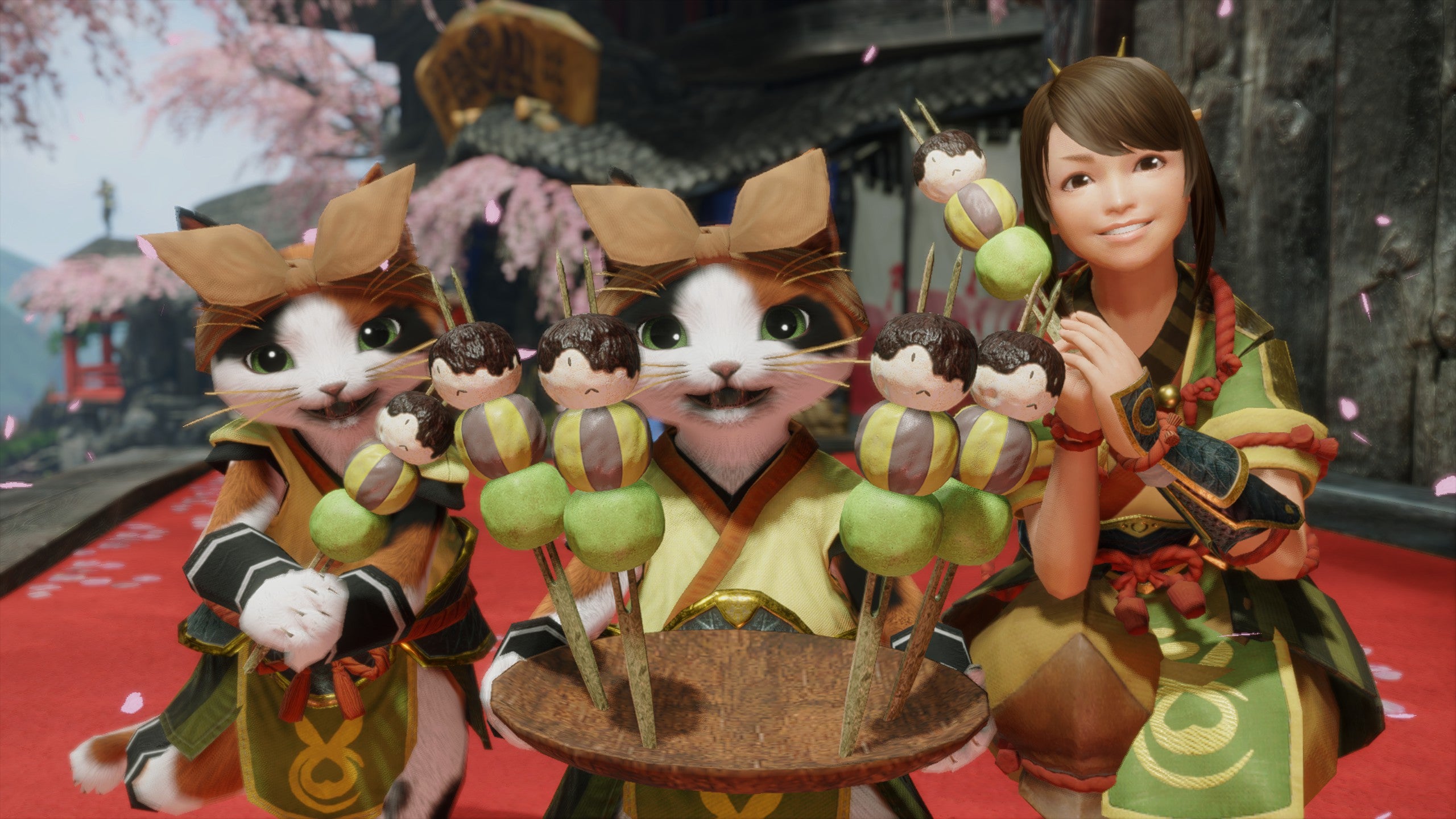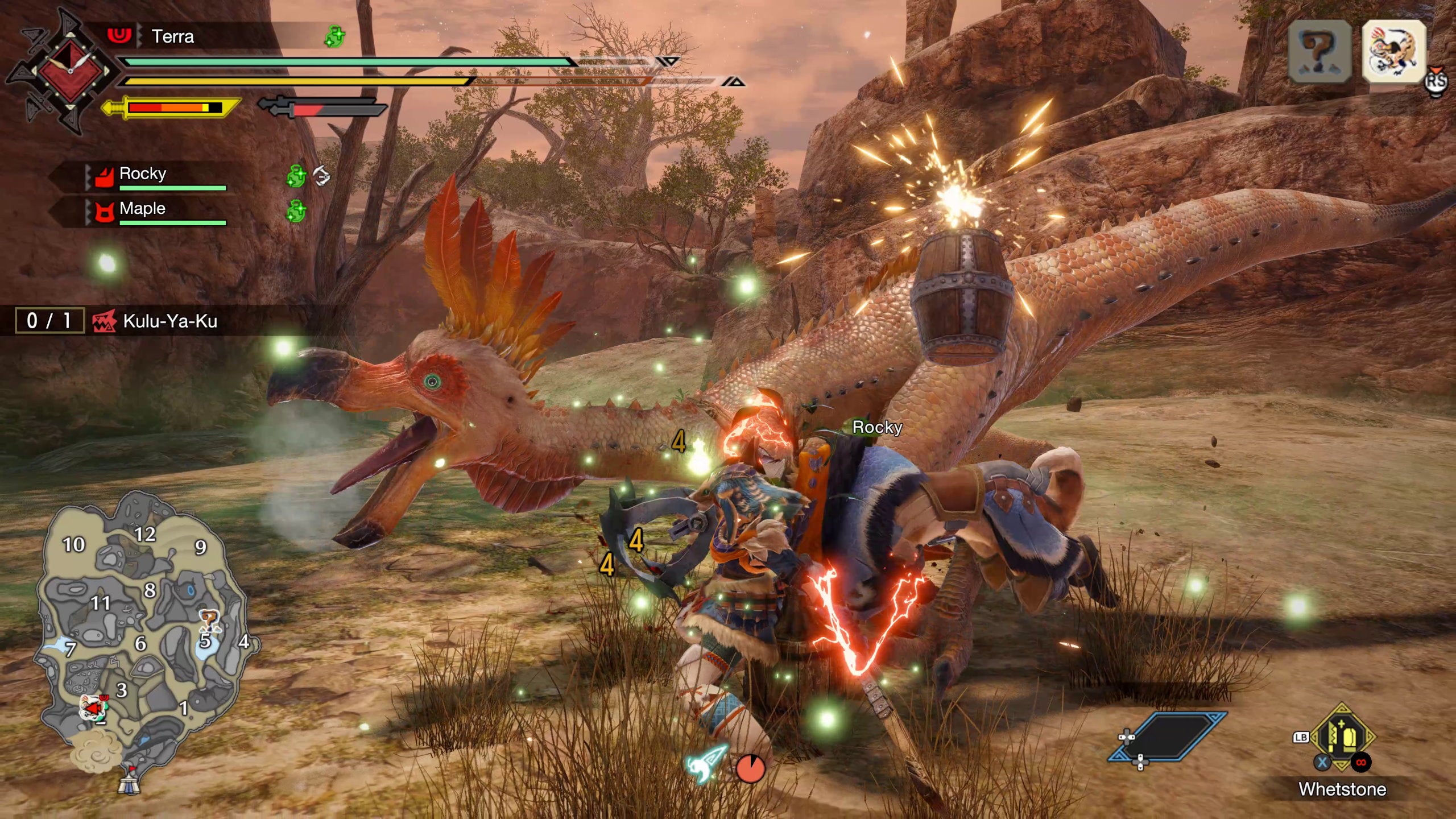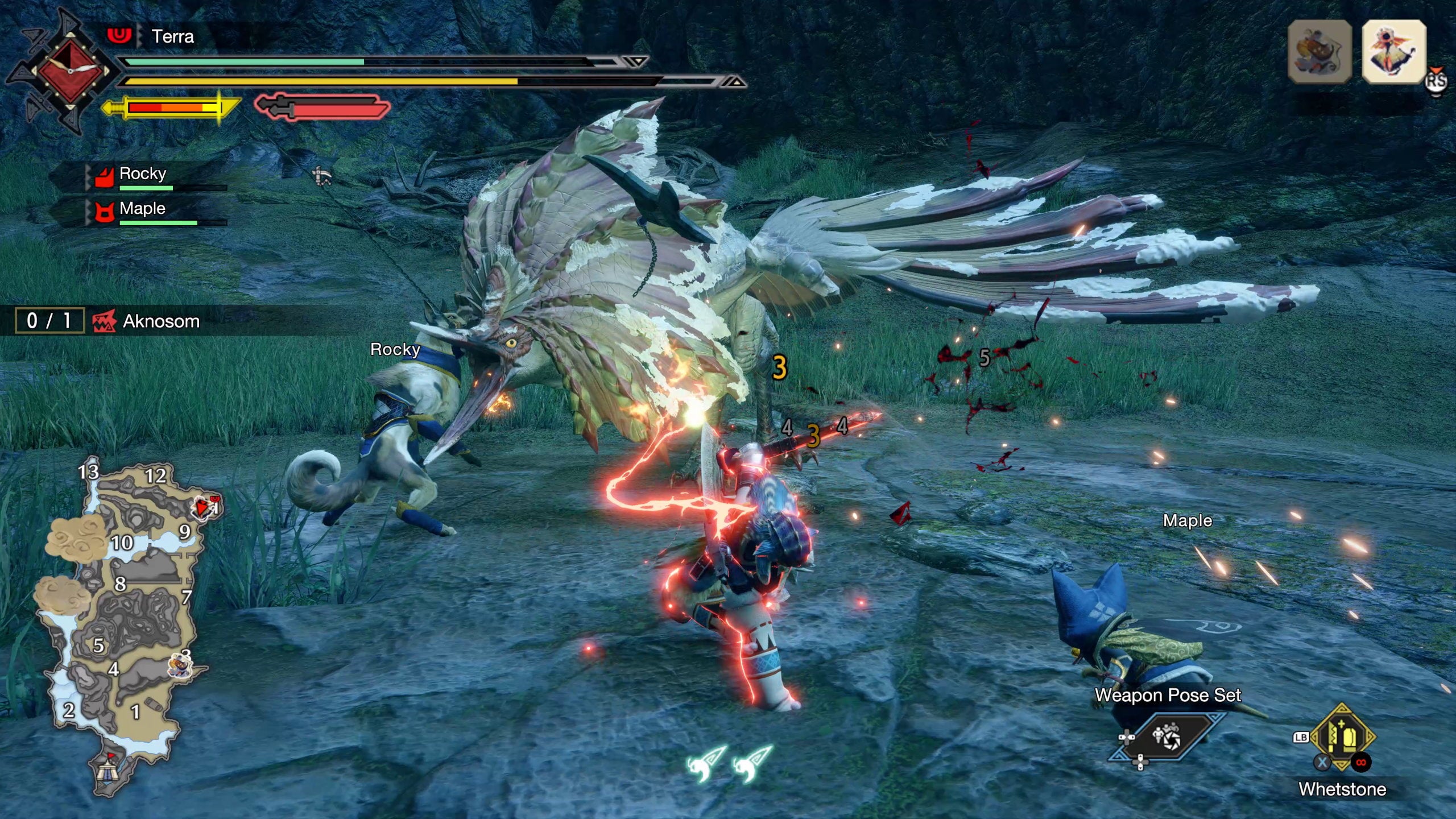The first of these twists is the wirebug, a giant, luminous firefly-cum-grapple hook that lets hunters launch themselves skyward, recover from brutish pratfalls, and put reins on stunned beasties so you can briefly ride them rodeo-style to dole out some mega hit points. It’s a highly versatile piece of equipment, giving rise (sorry) to not just the game’s moniker, but also what elevates it from the rest of the series. Away from battle, the wirebugs turn Monster Hunter Rise’s maps into veritable playgrounds, letting you clamber up sheer cliff faces that previously would have been nothing more than empty set dressing. Helpful trails of stat-buffing Spiribirds are on hand to guide your eye toward certain resource-rich locations tucked away from the main path, but following your nose to your own discoveries is all part of the fun. Sure, you’re curtailed by your stamina bar and the number of wirebugs currently at your disposal, but overall these little beetles bring a welcome sense of openness to Rise that even World’s enormous biomes sometimes struggled to convey. Indeed, climbing to the highest peak and spotting your quarry having a wash in the stream down below on the far side of the map (thanks, increased draw distances) is a thrill that never gets old. Neither does whipping them out for a quick recovery swing when you’re really in the thick of it. I’m not gonna lie. As someone who often gets a big too carried away swinging her Dual Blades around in the heat of battle, I’ve probably spent as much time being knocked flat on my arse as I have standing upright. As long as you’ve got a fresh wirebug to hand, though, a quick squeeze of the left trigger and a tap of A will now yoink you to safety rather than break the flow of battle as you nurse your bruised glutes (I should also note that while keyboard controls are serviceable here, using a controller is definitely recommended). This isn’t merely about saving face. Picking yourself back up after a proper walloping always felt a little jarring in previous Monster Hunter games, but breaking your fall with a cheeky wirebug helps keep the momentum going and gets you back into the fight faster. They’re also just great fun for hurling yourself at enemies like an anime super warrior. Like previous entries, dealing damage while airborne brings you closer to being able to mount monsters for extra damage - a concept first introduced in Monster Hunter 4 with the pole-vault-style Insect Glaive, and later expanded in World to give all weapon classes a taste of the action. Rise, however, really goes to town with it, adding a raucous rodeo element that sees you take direct control of your foe, and even attack other monsters with it. Turning monsters’ signature attacks against their own is real crowd-pleasing stuff, and the enduring physicality of these wriggling wyverns has never felt stronger. They’re tough to control, but so they should be given their size and might, and the tension that comes with trying to make the most of these brief windows never fails to raise your heartbeat. As always, the goal of hunting these scaly beasts is to harvest their flesh for precious hides, fangs and scales to forge ever stronger sets of armour and weapons for you and your two animal companions. You can only carve off three bits of monster after any given hunt, although your cat-like Palico and dog-friend Palamute will often scavenge a few extra doodads on your behalf to help bulk up the numbers. Even so, you rarely have enough to craft a complete armour set after just one hunt, so you’ll often have to head back out for another round to fill in the gaps. This is the age-old rhythm of a Monster Hunter game, creating a natural grind that some may just not have the patience for. Personally, though, I rarely had to repeat specific missions just to get at particular monsters, as there’s usually a handful of them roaming around anyway, regardless of what mission you’re on. Sure, you’ll still have to go through the same 15-20 minute tussles in order to take them down again, but the generous 50 minute time limit means they’re usually pretty comfortable detours - especially when you can see exactly where they (and your actual target) are on the map. Heck, even the usually tedious resource gathering missions have been speeded up by letting players ride on the back on their Palamute. All this arguably makes Rise one of the most friendly and streamlined Monster Hunter games yet, although you’ll still have to wade through an inordinate number of text box tutorials at the start before you’re left alone to properly enjoy it. Accessibility has never been one of Monster Hunter’s strong suits, and Rise, too, struggles to show rather than tell you how to get the best from it. Much of it should feel familiar if you’ve built up some muscle memory from World over the years, but newcomers are likely to still feel quite daunted by it all. The one thing I am thankful for, though, is a marked shift away from capturing monsters as opposed to just hunting them. Capturing monsters with traps is something I’ve been bad at in previous Monster Hunter games, and getting stuck on these missions has often been the reason I’ve stopped playing them. With Rise, however, there isn’t a single capture mission until after the first end credits and you unlock the level 5 missions. Superior hunters can still trap and capture monsters whenever they wish, of course (and get rarer material not available via carving in the process), but the lack of emphasis on it in the main campaign is a very welcome change. The only slightly bum note in Monster Hunter Rise’s roster is its new Rampage missions. Rather than heading out into the wider world for these, Rampage missions see you protect your home hub town of Kamura Village from waves of monsters in a kind of arena-based tower defence game. It’s a fun diversion the first time you do it, but firing at monsters from mounted gun turrets is nowhere near as gripping as a proper hunt. Thankfully, these too can be largely ignored if you’d rather stick to traditional monster slaying, but the fact they just get packed off into a separate mission menu, potentially never to be seen of or heard from again, does somewhat undermine the thrust of the main story. The village elders would have you believe Kamura Village is constantly on the verge of being annihilated by these rampaging beasts, but that tension never really manifests in the overarching mission structure. As underwhelming as the Rampage missions are compared to regular hunts, even I was surprised I only ever had to do the one of them as part of the main campaign before I saw the first set of end credits. For the most part, though, Monster Hunter Rise is another stonking addition to the series, and in my books a more than worthy successor to Monster Hunter: World. There’s a generous and playful sense of freedom here that keeps combat and exploration feeling fresh, and the momentum of its hunting-led missions means you’re rarely spinning your wheels as you seek out that last elusive armour part. It’s kept me playing much longer than I ever did with World, and I can’t wait to see how it develops with its imminent Sunbreak expansion later this summer.




